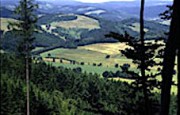Towards integrated wildlife management in the Vienna Woods
The Vienna Woods for most people means a tuneful waltz by Johann Strauss. Few will know that it is also the name of a recently designated wildlife management area (Wienerwald Biosphere Reserve) stretching out from the edges of the Austrian capital into heavily used countryside. The reserve has been the setting for an important initiative to design tools for cross sectoral land management according to the internationally recognised sustainable use principles.
Wild animals and their habitats are exposed to multiple impacts caused by hunting and many other overlapping and competing landuse activities within the habitat. In particular in multiple use cultural landscapes the interaction between the habitat requirements of wild animals, hunting interests and other landuse demands often leads to conflicts. Such conflicts can negatively affect sustainable conservation of native wild animal species and their habitats, the sustainability of some types of land use, and sustainable regional development more widely. Standalone sectoral approaches to sustainable use are insufficient and often result in unintended adverse effects on other land use sectors and the respective ecosystem. In contrast, sustainable wildlife management requires that all landuser groups in the wildlife habitat are aware of and consider the effects of their activities on both wildlife resources and other user groups.
With this in mind, concepts and tools for integrated sustainability assessment of several land user groups have been developed in the area of the “Wienerwald Biosphere Reserve” focussing on "wild animals and hunting” as a central concept the reserve is an intensively used region which features forestry, agriculture, hunting, and different kinds of leisure activity. As is normal for biosphere reserves the main aim is the development and implementation of sustainable land use concepts. Applied participatory research methods have been developed to identify, analyse and evaluate key interfaces and positive or negative linkages between wildlife populations, wildlife habitats and different forms of regional land use. The main project outputs are four operational sets of principles, criteria and indicators for integrated sustainable wildlife management, focused on the major regional landuser groups forestry, agriculture, hunting, and recreation management.
These four assessment sets are harmonised across the landuse sectors and designed as self evaluation tools. The idea is that they should be applied by each of the four landuser groups in order to evaluate their respective influence on the sustainable conservation of wild animal species, their habitats and sustainable hunting. The assessment framework of each group also considers the relevant sustainability requirements of other user groups. By focussing on the crosscutting issue of "wildlife management", the step from merely sectorspecific towards integrated assessment of sustainable use has been taken for the first time. Moreover, recommendations for integrated sustainable wildlife management and for respective monitoring have been elaborated. Project results are intended to contribute to the avoidance, mitigation and resolution of wildlife landuse conflicts and to the integration of wild animals and their management into a sustainable regional landuse system. The land user groups of the Biosphere Reserve region comprise private, community, and public organizations. The publication of the study results, including the four assessment sets as annexes, is available for download at the homepage of the Austrian Academy of Sciences: http://epub.oeaw.ac.at/? arp=0x002b150e (German version 2009, English version 2012).
This project was a further development of former studies (since 2001) on the assessment of sustainable hunting taking into account the “three pillars” of sustainability (ecological, economic, and sociocultural components) in accordance with international conventions about sustainable use of natural resources (CBD, IUCN); these studies were a basis e.g. for the IUCN/SSC/ESUSG Guidelines on Sustainable Hunting in Europe (ESUSGWISPER 2006) and the European Charter on Hunting and Biodiversity (2007). Publications on these former studies are available for download at the homepage of the Environment Agency Austria: http://www.umweltbundesamt.at/aktuell/presse/lastnews/newsarchiv_2012/news_12013/; and http://www.biologischevielfalt.at/nachhaltigenutzung/kriterienundindikatoreneiner nachhaltigenjagd/.
Friedrich Reimoser (2013)
Research Institute of Wildlife Ecology
University of Veterinary Medicine, Vienna/Austria
Photo: Landscape in Vienna Woods Biosphere Reserve. Credit: F. Reimoser
→ siehe hierzu auch den Artikel: Fust-Initiative: Integriertes Wildtiermanagement


